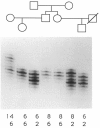Abstract
Dopa-responsive dystonia is a clinical variant of idiopathic torsion dystonia that is distinguished from other forms of dystonia by the frequent cooccurrence of parkinsonism, diurnal fluctuation of symptoms, and its dramatic therapeutic response to L-dopa. Linkage of a gene causing classic dystonia in a large non-Jewish kindred (DYT1) and in a group of Ashkenazi Jewish families, to the gelsolin (GSN) and argininosuccinate synthetase (ASS) loci on chromosome 9q32-34, respectively, was recently determined. Here we report the discovery of a highly informative (GT)n repeat VNTR polymorphism within the ASS locus. Analysis of a large kindred with dopa-responsive dystonia, using this new polymorphism and conventional RFLPs for the 9q32-34 region, excludes loci in this region as a cause of this form of dystonia. This provides proof of genetic heterogeneity between classic idiopathic torsion dystonia and dopa-responsive dystonia.
Full text
PDF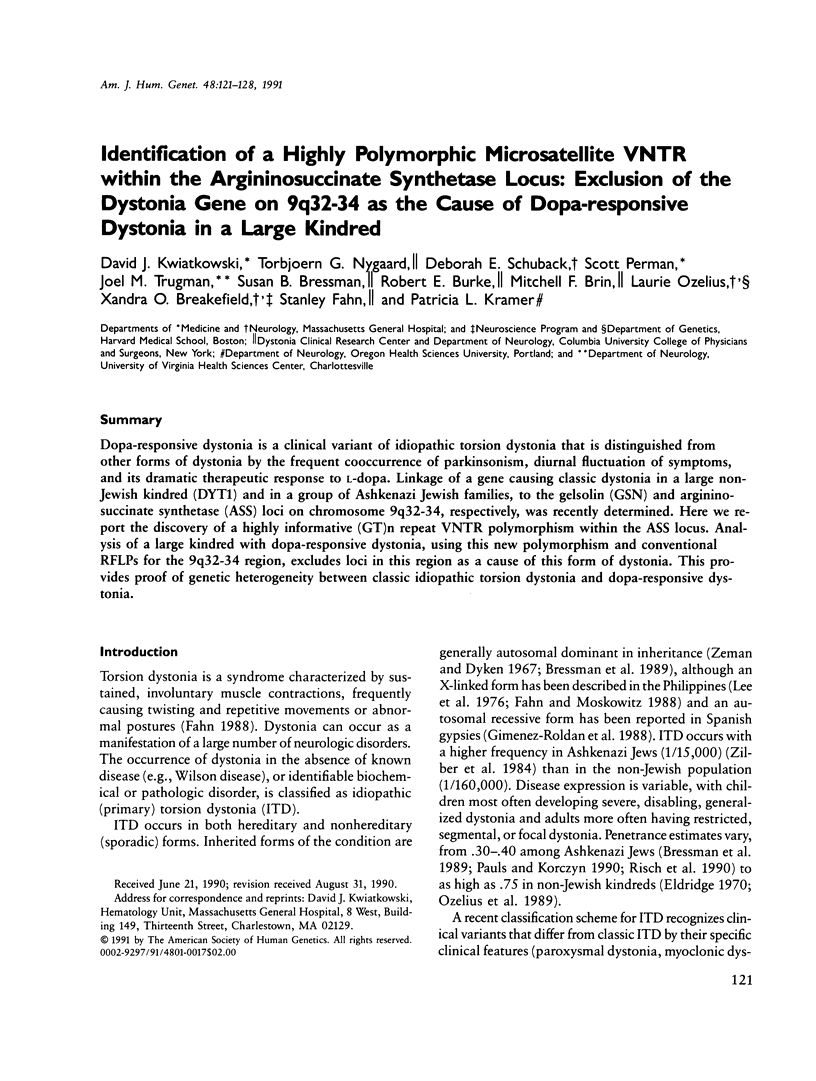
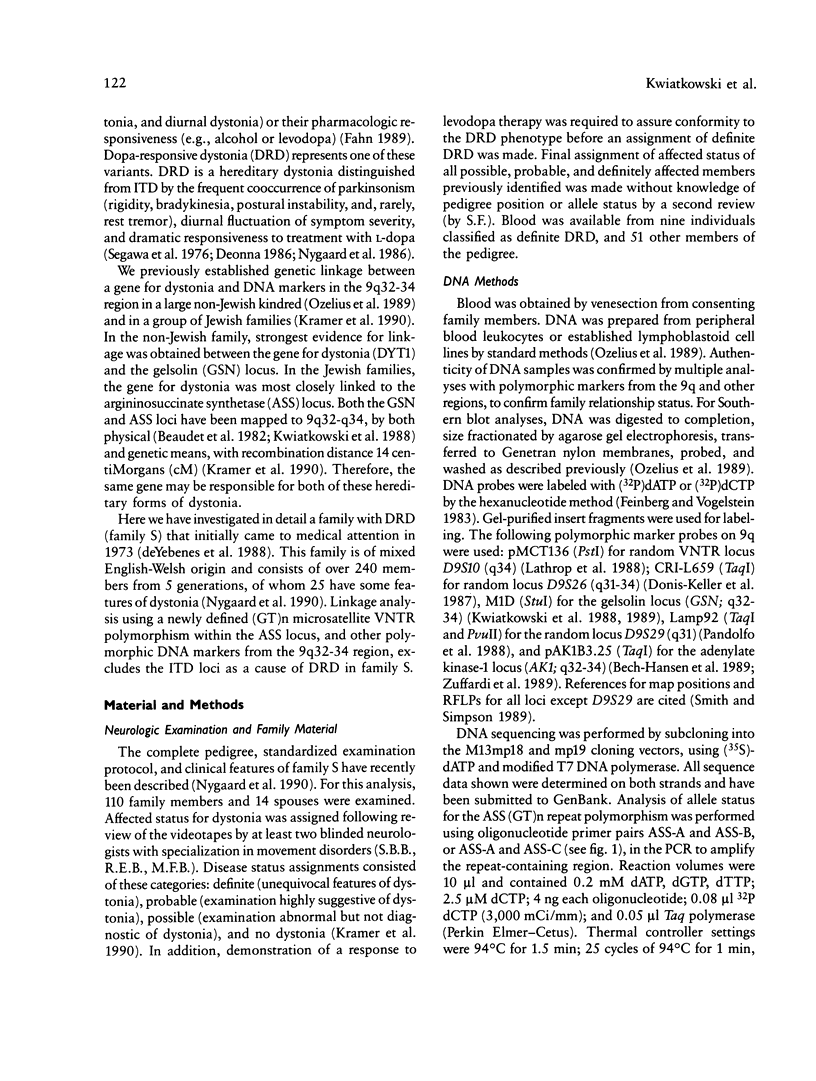
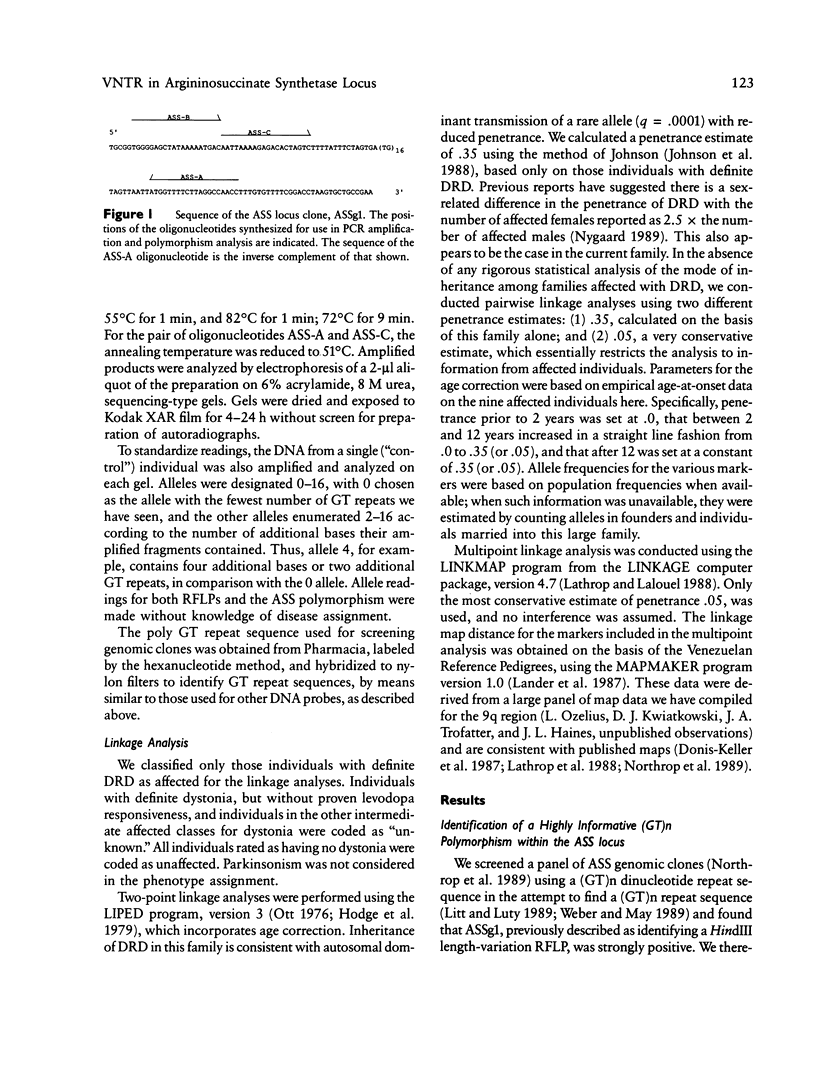
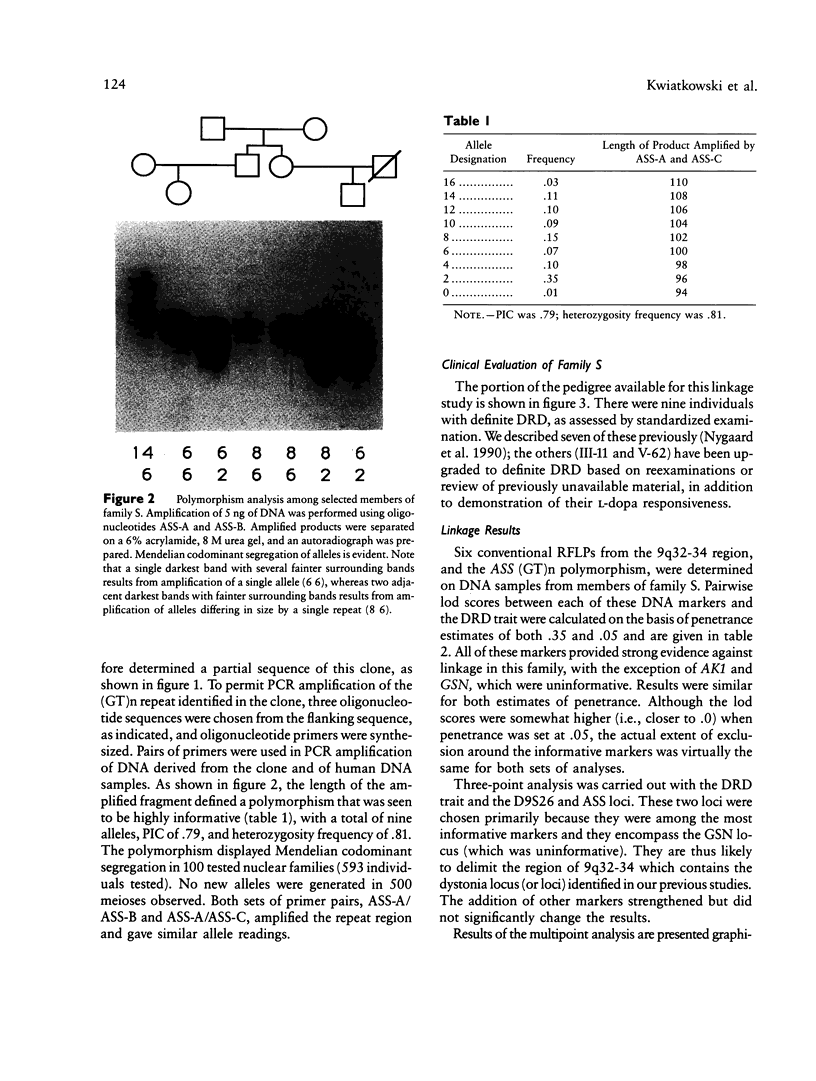
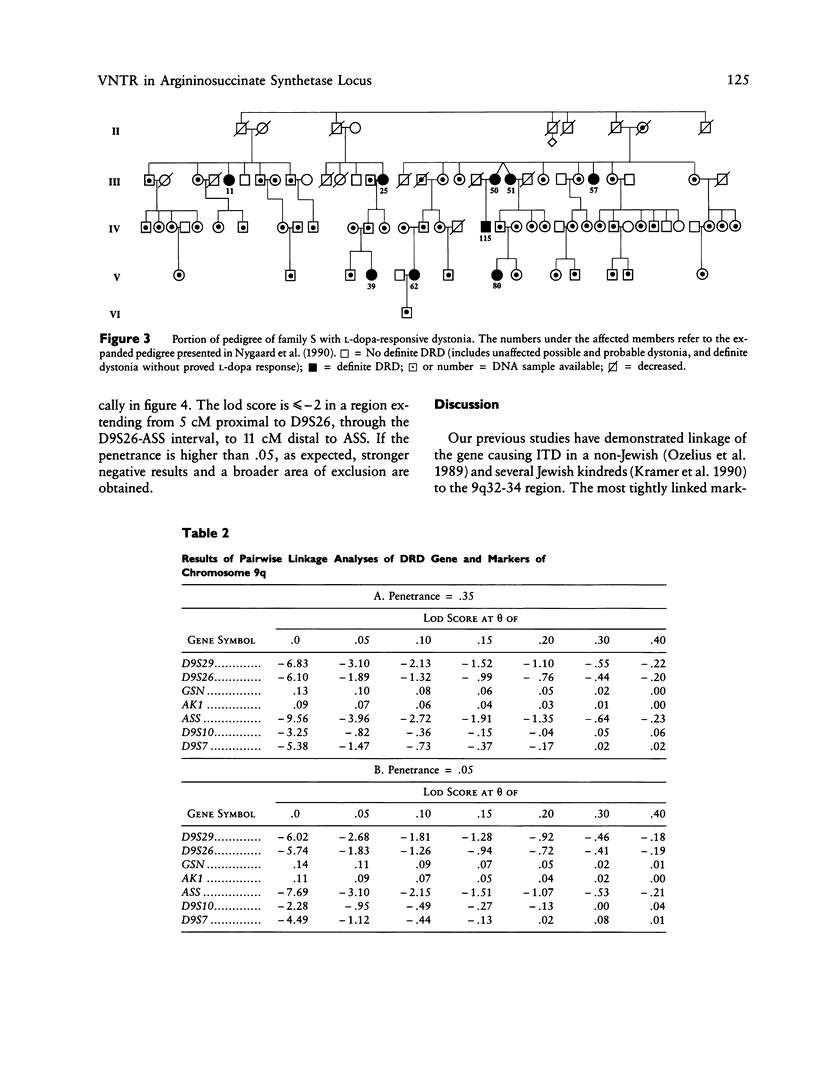

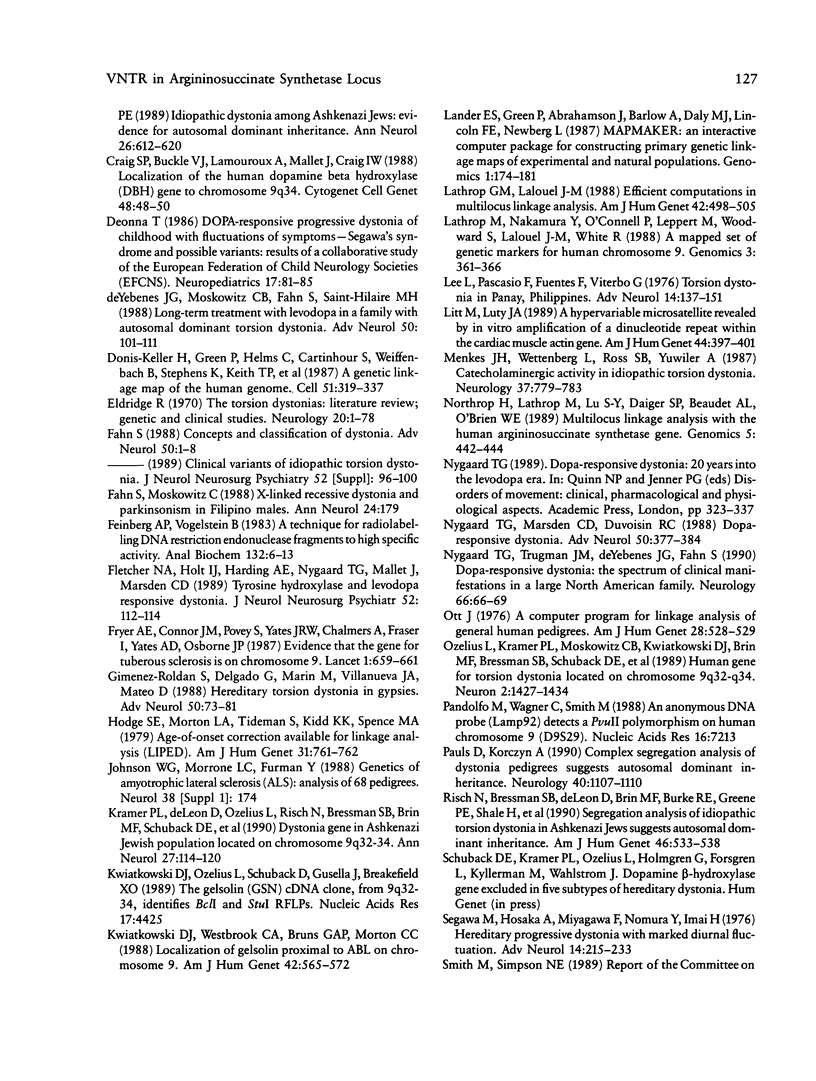
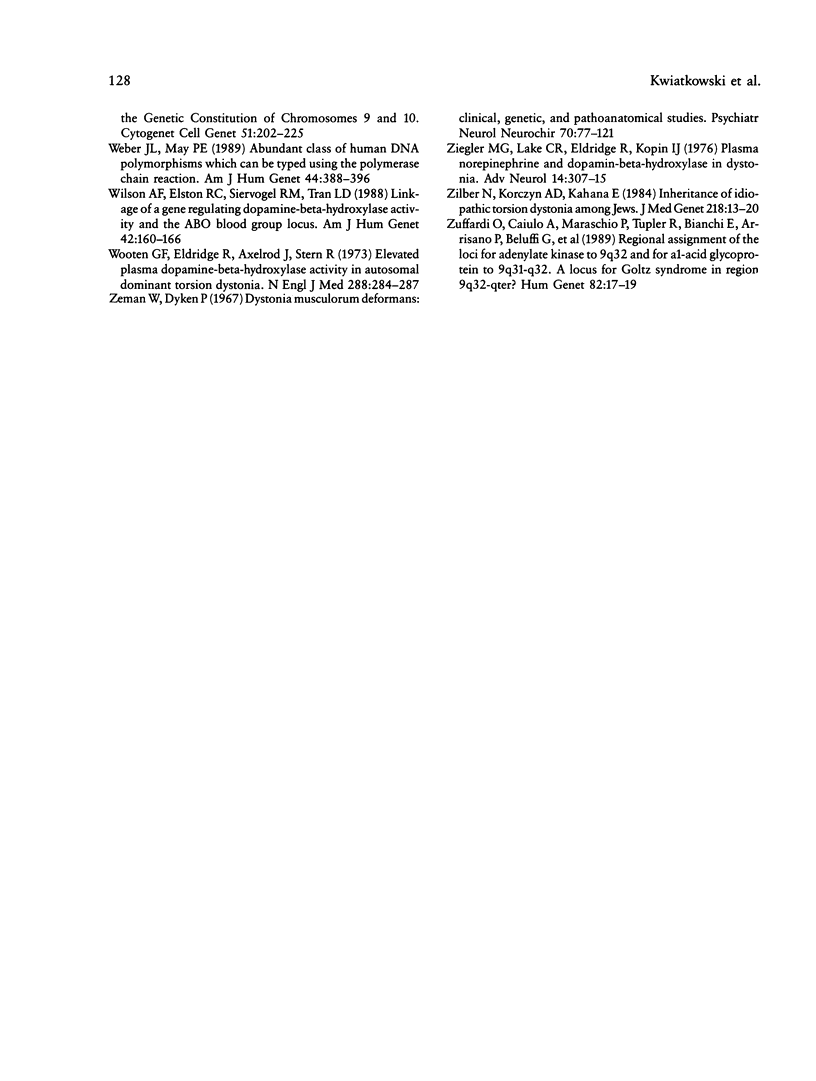
Images in this article
Selected References
These references are in PubMed. This may not be the complete list of references from this article.
- Beaudet A. L., Su T. S., O'Brien W. E., D'Eustachio P., Barker P. E., Ruddle F. H. Dispersion of argininosuccinate-synthetase-like human genes to multiple autosomes and the X chromosome. Cell. 1982 Aug;30(1):287–293. doi: 10.1016/0092-8674(82)90034-4. [DOI] [PubMed] [Google Scholar]
- Bech-Hansen N. T., Marshall K. J., Kraus S. L. TaqI RFLP in human adenylate kinase-1 (AK1) gene region on chromosome 9. Nucleic Acids Res. 1989 May 25;17(10):4004–4004. doi: 10.1093/nar/17.10.4004. [DOI] [PMC free article] [PubMed] [Google Scholar]
- Bressman S. B., de Leon D., Brin M. F., Risch N., Burke R. E., Greene P. E., Shale H., Fahn S. Idiopathic dystonia among Ashkenazi Jews: evidence for autosomal dominant inheritance. Ann Neurol. 1989 Nov;26(5):612–620. doi: 10.1002/ana.410260505. [DOI] [PubMed] [Google Scholar]
- Craig S. P., Buckle V. J., Lamouroux A., Mallet J., Craig I. W. Localization of the human dopamine beta hydroxylase (DBH) gene to chromosome 9q34. Cytogenet Cell Genet. 1988;48(1):48–50. doi: 10.1159/000132584. [DOI] [PubMed] [Google Scholar]
- Deonna T. DOPA-sensitive progressive dystonia of childhood with fluctuations of symptoms--Segawa's syndrome and possible variants. Results of a collaborative study of the European Federation of Child Neurology Societies (EFCNS). Neuropediatrics. 1986 May;17(2):81–85. doi: 10.1055/s-2008-1052506. [DOI] [PubMed] [Google Scholar]
- Donis-Keller H., Green P., Helms C., Cartinhour S., Weiffenbach B., Stephens K., Keith T. P., Bowden D. W., Smith D. R., Lander E. S. A genetic linkage map of the human genome. Cell. 1987 Oct 23;51(2):319–337. doi: 10.1016/0092-8674(87)90158-9. [DOI] [PubMed] [Google Scholar]
- Eldridge R. The torsion dystonias: literature review and genetic and clinical studies. Neurology. 1970 Nov;20(11):1–78. doi: 10.1212/wnl.20.11_part_2.1. [DOI] [PubMed] [Google Scholar]
- Fahn S. Concept and classification of dystonia. Adv Neurol. 1988;50:1–8. [PubMed] [Google Scholar]
- Feinberg A. P., Vogelstein B. A technique for radiolabeling DNA restriction endonuclease fragments to high specific activity. Anal Biochem. 1983 Jul 1;132(1):6–13. doi: 10.1016/0003-2697(83)90418-9. [DOI] [PubMed] [Google Scholar]
- Fletcher N. A., Holt I. J., Harding A. E., Nygaard T. G., Mallet J., Marsden C. D. Tyrosine hydroxylase and levodopa responsive dystonia. J Neurol Neurosurg Psychiatry. 1989 Jan;52(1):112–114. doi: 10.1136/jnnp.52.1.112. [DOI] [PMC free article] [PubMed] [Google Scholar]
- Fryer A. E., Chalmers A., Connor J. M., Fraser I., Povey S., Yates A. D., Yates J. R., Osborne J. P. Evidence that the gene for tuberous sclerosis is on chromosome 9. Lancet. 1987 Mar 21;1(8534):659–661. doi: 10.1016/s0140-6736(87)90416-8. [DOI] [PubMed] [Google Scholar]
- Giménez-Roldán S., Delgado G., Marín M., Villanueva J. A., Mateo D. Hereditary torsion dystonia in gypsies. Adv Neurol. 1988;50:73–81. [PubMed] [Google Scholar]
- Kramer P. L., de Leon D., Ozelius L., Risch N., Bressman S. B., Brin M. F., Schuback D. E., Burke R. E., Kwiatkowski D. J., Shale H. Dystonia gene in Ashkenazi Jewish population is located on chromosome 9q32-34. Ann Neurol. 1990 Feb;27(2):114–120. doi: 10.1002/ana.410270203. [DOI] [PubMed] [Google Scholar]
- Kwiatkowski D. J., Ozelius L., Schuback D., Gusella J., Breakefield X. O. The gelsolin (GSN) cDNA clone, from 9q32-34, identifies BclI and StuI RFLPs. Nucleic Acids Res. 1989 Jun 12;17(11):4425–4425. doi: 10.1093/nar/17.11.4425. [DOI] [PMC free article] [PubMed] [Google Scholar]
- Kwiatkowski D. J., Westbrook C. A., Bruns G. A., Morton C. C. Localization of gelsolin proximal to ABL on chromosome 9. Am J Hum Genet. 1988 Apr;42(4):565–572. [PMC free article] [PubMed] [Google Scholar]
- Lander E. S., Green P., Abrahamson J., Barlow A., Daly M. J., Lincoln S. E., Newberg L. A., Newburg L. MAPMAKER: an interactive computer package for constructing primary genetic linkage maps of experimental and natural populations. Genomics. 1987 Oct;1(2):174–181. doi: 10.1016/0888-7543(87)90010-3. [DOI] [PubMed] [Google Scholar]
- Lathrop G. M., Lalouel J. M. Efficient computations in multilocus linkage analysis. Am J Hum Genet. 1988 Mar;42(3):498–505. [PMC free article] [PubMed] [Google Scholar]
- Lathrop M., Nakamura Y., O'Connell P., Leppert M., Woodward S., Lalouel J. M., White R. A mapped set of genetic markers for human chromosome 9. Genomics. 1988 Nov;3(4):361–366. doi: 10.1016/0888-7543(88)90128-0. [DOI] [PubMed] [Google Scholar]
- Lee L. V., Pascasio F. M., Fuentes F. D., Viterbo G. H. Torsion dystonia in Panay, Philippines. Adv Neurol. 1976;14:137–151. [PubMed] [Google Scholar]
- Litt M., Luty J. A. A hypervariable microsatellite revealed by in vitro amplification of a dinucleotide repeat within the cardiac muscle actin gene. Am J Hum Genet. 1989 Mar;44(3):397–401. [PMC free article] [PubMed] [Google Scholar]
- Menkes J. H., Wetterberg L., Ross S. B., Yuwiler A. Catecholaminergic activity in idiopathic torsion dystonia. Neurology. 1987 May;37(5):779–783. doi: 10.1212/wnl.37.5.779. [DOI] [PubMed] [Google Scholar]
- Northrup H., Lathrop M., Lu S. Y., Daiger S. P., Beaudet A. L., O'Brien W. E. Multilocus linkage analysis with the human argininosuccinate synthetase gene. Genomics. 1989 Oct;5(3):442–444. doi: 10.1016/0888-7543(89)90007-4. [DOI] [PubMed] [Google Scholar]
- Nygaard T. G., Marsden C. D., Duvoisin R. C. Dopa-responsive dystonia. Adv Neurol. 1988;50:377–384. [PubMed] [Google Scholar]
- Nygaard T. G., Trugman J. M., de Yebenes J. G., Fahn S. Dopa-responsive dystonia: the spectrum of clinical manifestations in a large North American family. Neurology. 1990 Jan;40(1):66–69. doi: 10.1212/wnl.40.1.66. [DOI] [PubMed] [Google Scholar]
- Ott J. A computer program for linkage analysis of general human pedigrees. Am J Hum Genet. 1976 Sep;28(5):528–529. [PMC free article] [PubMed] [Google Scholar]
- Ozelius L., Kramer P. L., Moskowitz C. B., Kwiatkowski D. J., Brin M. F., Bressman S. B., Schuback D. E., Falk C. T., Risch N., de Leon D. Human gene for torsion dystonia located on chromosome 9q32-q34. Neuron. 1989 May;2(5):1427–1434. doi: 10.1016/0896-6273(89)90188-8. [DOI] [PubMed] [Google Scholar]
- Pandolfo M., Wagner C., Smith M. An anonymous DNA probe (LAMP 92) detects a Pvu II polymorphism on human chromosome 9 [D9S29]. Nucleic Acids Res. 1988 Jul 25;16(14B):7213–7213. doi: 10.1093/nar/16.14.7213. [DOI] [PMC free article] [PubMed] [Google Scholar]
- Pauls D. L., Korczyn A. D. Complex segregation analysis of dystonia pedigrees suggests autosomal dominant inheritance. Neurology. 1990 Jul;40(7):1107–1110. doi: 10.1212/wnl.40.7.1107. [DOI] [PubMed] [Google Scholar]
- Risch N. J., Bressman S. B., deLeon D., Brin M. F., Burke R. E., Greene P. E., Shale H., Claus E. B., Cupples L. A., Fahn S. Segregation analysis of idiopathic torsion dystonia in Ashkenazi Jews suggests autosomal dominant inheritance. Am J Hum Genet. 1990 Mar;46(3):533–538. [PMC free article] [PubMed] [Google Scholar]
- Segawa M., Hosaka A., Miyagawa F., Nomura Y., Imai H. Hereditary progressive dystonia with marked diurnal fluctuation. Adv Neurol. 1976;14:215–233. [PubMed] [Google Scholar]
- Smith M., Simpson N. E. Report of the committee on the genetic constitution of chromosomes 9 and 10. Cytogenet Cell Genet. 1989;51(1-4):202–225. doi: 10.1159/000132792. [DOI] [PubMed] [Google Scholar]
- Weber J. L., May P. E. Abundant class of human DNA polymorphisms which can be typed using the polymerase chain reaction. Am J Hum Genet. 1989 Mar;44(3):388–396. [PMC free article] [PubMed] [Google Scholar]
- Wilson A. F., Elston R. C., Siervogel R. M., Tran L. D. Linkage of a gene regulating dopamine-beta-hydroxylase activity and the ABO blood group locus. Am J Hum Genet. 1988 Jan;42(1):160–166. [PMC free article] [PubMed] [Google Scholar]
- Wooten G. F., Eldridge R., Axelrod J., Stern R. S. Elevated plasma dopamine- -hydroxylase activity in autosomal dominant torsion dystonia. N Engl J Med. 1973 Feb 8;288(6):284–287. doi: 10.1056/NEJM197302082880604. [DOI] [PubMed] [Google Scholar]
- Zeman W., Dyken P. Dystonia musculorum deformans. Clinical, genetic and pathoanatomical studies. Psychiatr Neurol Neurochir. 1967 Mar-Apr;70(2):77–121. [PubMed] [Google Scholar]
- Ziegler M. G., Lake C. R., Eldridge R., Kopin I. J. Plasma norepinephrine and dopamine-beta-hydroxylase in dystonia. Adv Neurol. 1976;14:307–318. [PubMed] [Google Scholar]
- Zilber N., Korczyn A. D., Kahana E., Fried K., Alter M. Inheritance of idiopathic torsion dystonia among Jews. J Med Genet. 1984 Feb;21(1):13–20. doi: 10.1136/jmg.21.1.13. [DOI] [PMC free article] [PubMed] [Google Scholar]
- Zuffardi O., Caiulo A., Maraschio P., Tupler R., Bianchi E., Amisano P., Beluffi G., Moratti R., Liguri G. Regional assignment of the loci for adenylate kinase to 9q32 and for alpha 1-acid glycoprotein to 9q31-q32. A locus for Goltz syndrome in region 9q32-qter? Hum Genet. 1989 Apr;82(1):17–19. doi: 10.1007/BF00288264. [DOI] [PubMed] [Google Scholar]
- de Yebenes J. G., Moskowitz C., Fahn S., Saint-Hilaire M. H. Long-term treatment with levodopa in a family with autosomal dominant torsion dystonia. Adv Neurol. 1988;50:101–111. [PubMed] [Google Scholar]



